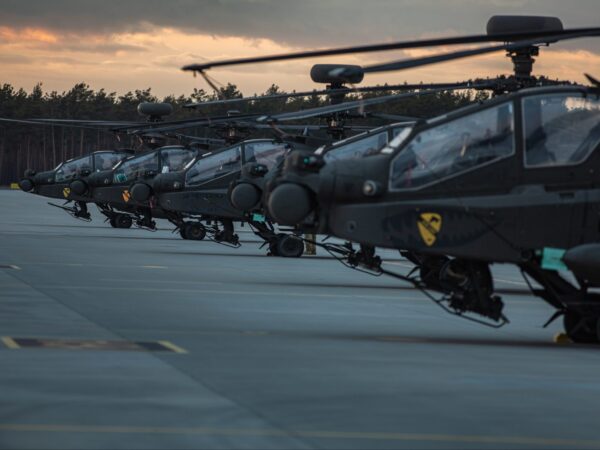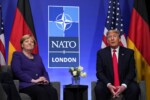In light of Russia’s unprovoked war on Ukraine, the Scowcroft Center for Strategy and Security’s Transatlantic Security Initiative convened a task force of Atlantic Council experts focused on strengthening US and NATO force posture. This Scowcroft Center Issue Brief outlines the strategic context that NATO now faces, key principles for strengthening NATO’s deterrence posture, and a menu of recommended posture enhancements for the Alliance.

Strategic context and key insights
We are now in a new era of sustained confrontation with Russia. It is not a broad-based competition for influence across numerous domains (e.g. economic), as is the case with China; rather, it is a dynamic confrontation throughout the transatlantic theater, most heatedly along NATO’s eastern flank from the Arctic in the north to the Black and Mediterranean Seas in the south. Russia wishes to push its influence or direct control of territory as far west, north, and south as possible, especially in the former Soviet states.
Russia has now demonstrated both the intent and capability to mass forces to underwrite a sustained coercive-diplomacy campaign and invade the sovereign territory of another nation. Moreover, now that Russian forces have undertaken operations in Ukraine, Putin may decide to further threaten the territory and freedom of action of additional non-NATO members, such as Georgia, Moldova, and Finland—as well as NATO members themselves. Russia today has a preponderance of conventional combat forces in Eastern Europe.
No matter what happens next regarding Russian military operations in Ukraine and Belarus, the security environment in Europe and adjoining regions has been structurally changed for the worse for the short to medium term. Thus, NATO’s approach of deterrence by punishment—conducted by rapid reinforcement to its frontline allies—can no longer be NATO’s sole model for deterrence. Deterrence by denial must now gain greater weight in NATO’s strategic concept.
Based on Russian actions, the 1997 NATO-Russia Founding Act—and its restrictions on NATO’s eastern posture—is no longer relevant. We are in new, dangerous territory—a period of sustained tensions, military moves and countermoves, and major intermittent military crises in the Euro-Atlantic area that will ebb and flow for at least the remainder of the 2020s, if not longer.
In this environment, military tensions will likely be exacerbated by increased, aggressive Russian unconventional activities in the homelands of NATO and European Union (EU) members. We should expect Russia, feeling the impact of coordinated Western sanctions and other diplomatic measures, will ramp up the level and intensity of cyberattacks, election meddling, online disinformation, covert activities, and support for extremists in homelands across the democratic world. On top of a local conventional-combat power imbalance between Russian and allied forces in Eastern Europe, and increasingly aggressive sub-threshold operations, the Alliance also faces a highly dynamic strategic-forces balance. Russia has undertaken a long-term, sustained nuclear-modernization program that has produced several new types of offensive nuclear weapons. These novel systems present new threats to NATO, its outmoded conceptual approach to nuclear deterrence, and its aging nuclear force inventories.
In turn, the Alliance will need to assure its nuclear deterrent capabilities. Modernized and adapted NATO nuclear capabilities must be prioritized in order for the Alliance to effectively deter numerically superior Russian forces from attacking NATO’s eastern-flank members, from Norway in the north through Lithuania, Poland, Hungary, Slovakia, Romania, and Turkey in the south. While this conclusion may run counter to the Biden administration’s initial proposition to reduce US reliance on nuclear weapons in its national security strategy, it would represent a clear-eyed reappraisal of the new security environment. That Biden administration commitment was made well before the ongoing Russian invasion of Ukraine. If President Biden were to wisely decide to reassess this policy position, he would likely gain bipartisan and Alliance-wide backing.
Though deterrence of Russia will take on greater weight in US defense planning, the threat posed by China will still demand significant resources. Thus, though the United States must play a leading role in shaping and contributing to an adapted NATO defense posture, the US capacity to contribute will be constrained by Indo-Pacific requirements, necessitating increased contributions in Europe from European allies and Canada.

US and allied posture adjustments so far
In the lead-up to Russia’s invasion of Ukraine, and since the outbreak of hostilities, the United States and NATO allies have undertaken numerous steps to bolster allied force posture in Eastern Europe, enhancing deterrence against more robust Russian aggression and demonstrating the Alliance’s ability to defend its eastern flank. Importantly, deployments have come from a diverse group of European and North American allies, and the activation of the NATO Response Force (NRF) will spur additional contributions. All told, the United States will have activated an additional fourteen thousand troops for deployment in Europe, along with twenty-eight fighters, four B-52 bombers, six tanker aircraft, and four warships. This brings total US personnel in Europe to nearly one hundred thousand.
European allies have made important contributions as well, with Germany, Canada, and the United Kingdom all reinforcing their NATO enhanced Forward Presence battlegroups in the Baltic states, France deploying forces to Romania as part of NATO’s activation of elements of the Very High Readiness Joint Task Force (VJTF), and allies such as Denmark, the Netherlands, and Spain sending additional aircraft to NATO’s air policing missions. With the activation of the NRF, it is likely we will see more troop commitments from European allies, as the majority of NRF forces are sourced from Europe. While the NRF is meant to be a temporary deployment, many of the European deployments, both those under way and those announced for the near future, lay the groundwork for a permanently larger NATO presence along the eastern flank, and should be built upon. A detailed list of posture adjustments undertaken by the Alliance can be found in the Appendix.

Strategic principles for allied posture enhancements
The increased deployments detailed above are an important step forward in shoring up NATO defense and deterrence in response to the current crisis. Given the sustained confrontation with Russia, the Alliance must consider how it can establish a revamped and sustainable force posture in response to the new enduring strategic reality. As allies determine immediate next steps to strengthen NATO posture and begin to plan for medium- and longer-term enhancements, they should keep in mind the following principles based on the strategic context and key assumptions above. Posture enhancements should:
- deter the threat of Russian escalation toward the Alliance’s easternmost members;
- increase the Alliance’s ability to contest Russian activity below the threshold of armed conflict;
- increase European roles and contributions to NATO defense and deterrence;
- establish a long-term, permanent presence across NATO’s entire eastern flank that is correlated to a clear-eyed assessment of Russian capabilities and actions;
- ensure that future posture developments are sustainable over the long term and account for military technological advancements;
- ensure future deployments include adequate logistics and support infrastructure to act as effective combat units, rather than just presence or training missions;
- ensure that future forward deployments are politically palatable for both the sending and host nations;
- give stark priority to land and air forces, given the nature of a potential conflict in Europe vs. the nature of an Indo-Pacific conflict, which would preference naval, air, and marine forces;
- more cohesively utilize national forces that are already operating or present along NATO’s eastern flank;
- clearly communicate the improvements to NATO posture and how they strengthen defense and deterrence to allied publics and Russia; and
- lay the foundation for medium- to long-term enhancements to long-range strike capabilities (e.g., hypersonic weapons).

Short- and long-term options for a new NATO defense posture
NATO and its members have already done much to shore up allied presence on the Alliance’s eastern flank, yet there is still more that should be done to support short-, medium-, and long-term strategic objectives. In the short term, NATO and individual allies should undertake several rapid measures to reassure frontline allies, deter immediate Russian escalation toward NATO, and begin to contest Russian coercion and aggression toward allies. Options for this include the following.
- Prioritize NATO intelligence, surveillance, and reconnaissance (ISR) systems to the Baltic and Black Seas. Currently, NATO maintains five AGS Global Hawk ISR systems in Italy. These should be prioritized to monitor Russian operations in Ukraine, Kaliningrad and Belarus—alongside additional Airborne Warning and Control System (AWACS) deployments—and can be used to enable the future deployment of indirect fires, improving NATO’s offensive capabilities in the east.
- Upgrade NATO’s air-policing missions to air-defense missions. The mandate for NATO’s beefed-up air-policing missions in the Baltic and Black Sea regions should be upgraded into air-defense missions. This would give the pilots involved more favorable rules of engagement, allowing them more options to engage with potentially hostile aircraft, and would incorporate ground-based air-defense capabilities, allowing NATO commanders to better control a conflict in the air.
- Integrate frontline national forces under NATO Command and Control (C2) on a Corps+ scale. Though NATO’s Concept for Defense and Deterrence of the Euro-Atlantic Area is improving the integration of national activities and deployments with NATO’s missions, in the short term, this could be stepped up to better utilize these forces in this critical moment. For example, this could include eastern-flank countries, in concert with NATO’s larger members, designating a significant portion of their forces to immediately fall under one of NATO’s existing commands for an agreed amount of time in order to display solidarity and build interoperability.
- Establish a military-mobility area along NATO’s eastern flank. NATO has long had issues related to military mobility and, while progress has been made, there are still bureaucratic and infrastructure challenges that inhibit the rapid movement and sustainment of forces into and throughout Europe. NATO allies should agree to enact a crisis movement plan along NATO’s eastern flank, which would streamline bureaucratic procedures and pre-designate mobility equipment, such as flatbed rail cars, to allow the swift north-south movement of forces in the Suwalki Gap and other areas. NATO should also consider the creation of a military mobility fund to add to European Union funding for mobility.
- Reconfigure the current US rotational presence. To further enhance the US Army presence in Eastern Europe, the ABCT and Combat Aviation Brigade (CAB), currently on rotational deployment to Europe as part of Operation Atlantic Resolve, should be aggregated in Poland and Romania for the remainder of their deployments. Aggregating the 3,800-strong ABCT and two-thousand-strong CAB will make it a much more effective fighting force than having it dispersed among seven eastern allies.
- In addition to these forces, the United States should consider the permanent deployment of Patriot missile batteries from Germany to eastern Poland. These batteries will protect forward-deployed units in Poland.
- Additional capabilities, such as counter-electronic warfare, could be moved into theater closer to deployed US and allied C4 (command, control, communication and computers) units, especially near Kaliningrad.
- Enhance US air-power presence and activity in Europe.
- Continue routine Bomber Task Force deployments across NATO’s eastern flank, from the Black Sea to the High North.
- The United States should increase the number of fighter squadrons in Europe from the current six squadrons to eight, for a total of two hundred aircraft. Priority should be given to deploying additional fifth-generation aircraft to augment the limited number of US F-35s already in Europe.
- With this increased number of aircraft, the Air Force should ensure that there is enough air-to-air refueling capability, either in the region or rapidly deployable to the region, and augment the current tanker fleet with additional aircraft as necessary.
- Expand US and European Special Operations Forces (SOF) activities. Allies should prepare SOF to support a legitimate Ukrainian insurgency, should the Ukrainian government fall and Russia establish a puppet regime. SOF units deployed to Poland and Romania can begin working with Ukrainian forces in those countries to plan for such an insurgency and conduct irregular-warfare training. Consideration should also be given to employing SOF elsewhere in the region, including in Georgia and Moldova, where unrest in South Ossetia, Abkhazia, and Transnistria, respectively, could force Russia to expend increasingly limited resources elsewhere.
- Conduct a NATO nuclear exercise. NATO should conduct a nuclear exercise in Western Europe and publicize it and its intent clearly, to reinforce the willingness of NATO to use nuclear weapons in response to a Russian nuclear attack while carefully managing the signals it sends to Moscow.
In the long term, NATO and individual allies should undertake a number of sustained measures that both deter above-threshold aggression and help contest Moscow’s sub-threshold escalatory behavior.
- Prioritize US Army presence in Europe. The US Army should provide the vast preponderance of US military force contributions in Europe, complemented by US Air Force (USAF) capabilities. The Army already has the backbone of a Corps HQ deployed to Poland in the form of the V Corps forward-deployed headquarters, and now has three armored brigade combat teams in Europe. Additional Army forces that should be deployed to Europe include
- permanently stationed V Corps in Poland, rather than the current model of a rotational forward-deployed headquarters;
- at least three more brigade-equivalent combat units permanently stationed in Poland, Germany, and Romania under the command of V Corps, which should be rotationally deployed to other eastern-flank members’ territory, supplementing additional European member force contributions; and
- permanently introduced US Army future long-range precision-fires systems into Europe. These should form the backbone of a robust conventional long-range artillery strike capability under the Army’s new Theater Fires Command, the 56th Artillery Command.
- Ramp up European contributions to NATO’s defense posture. European allies should provide the preponderance of air and naval forces, and significant ground-force capabilities needed for deterrence in Europe, given US Indo-Pacific requirements. Already, there are numerous allied forces available and operating that are not currently accounted for in NATO’s defense posture, including more than one hundred aircraft and one hundred ships. Additionally, European allies should consider
- exercising the Joint Expeditionary Force (JEF) in the Baltic Sea region; and
- creating a baseline of four or more European/Canadian brigade combat teams (BCTs) in Eastern Europe on a rotational basis, building to a permanent basis. These BCTs should be sourced from France, Germany, the United Kingdom, and others, with enablers such as engineering, logistics, reconnaissance, and strike capabilities provided by other allies.
- Enable a multi-domain approach to contest Russian activity. The United States has also stood up a five-hundred-person-strong Multi-Domain Task Force that integrates intelligence, information, cyber, electronic-warfare, and space capabilities. This could serve as the inspiration for new multi-domain units from capable NATO allies, such as France, the UK, Germany, and Poland, focused on integrated deterrence of Russian coercion and aggression against NATO’s eastern-flank members.
- Sustain the Bomber Task Force Mission. USAF capability contributions to the new NATO integrated deterrent should include
- rotational deployments (once every six months) of Bomber Task Forces to the United Kingdom; and
- the current B-52 Bomber Task Force mission should, in the long term, be recodified into a Continuous Bomber Presence mission, with rotations of B-52 and B-1 bombers to Europe.
- Invest in development of unmanned aerial vehicles (UAVs). Unmanned, low-cost attritable aircraft (L-CAAT) that can launch without the need for an airfield and are able to operate in artificial intelligence-enabled formations will be a cost-effective force multiplier for NATO countries. Investment should be targeted at these types of systems and they should be incorporated into allied formations.
- Modernize NATO’s strategic posture. NATO is a nuclear alliance, and nuclear weapons will continue to be a key element of NATO’s deterrence and defense posture. The United States’ strategic weapons are the backbone of NATO’s nuclear posture, and are complemented by the nuclear capabilities of France and the United Kingdom. These capabilities should reinforce and supplement improvements to the Alliance’s conventional force posture in Europe. The United States and Russia have strategic parity under the New Strategic Arms Reduction Treaty (New START) agreement, which provides for a weapons ceiling of 1550. Nevertheless, NATO’s strategic posture needs to be brought into the 2020s to credibly deter Russian aggression and coercion. Modernization efforts should include the following.
- US investment in modernization of its nuclear triad—including the Ground-Based Strategic Deterrent, the Long-Range Standoff Weapon, the B-21 Raider strategic bomber, and the Columbia-class nuclear submarine—as the weapons systems in the triad are aging, and more costly to maintain over time than to modernize. Newer systems, including nuclear command-and-control upgrades, will enhance survivability and reliability.
- US development of the nuclear sea-launched cruise missile (SLCM-N) and, once it is operational, integration of the system into its strategic posture for Europe. This will add to the ability of the Alliance to have a full-spectrum nuclear capability, with necessary targeting and survivability capabilities sufficient to offset any perceived advantage that Russia’s larger inventory of nonstrategic nuclear weapons might suggest.
- Continued engagement of the full Alliance through the operation of dual-capable aircraft, support to the nuclear mission, and/or planning in the Nuclear Planning Group.
- Deployment of effective air and cruise-missile defense capabilities, including advanced PAC-3 interceptors.
- Accelerated development and testing of directed-energy missile defenses, particularly for air and cruise-missile defense, so that such capabilities can be deployed to Europe this decade. The potential cost-effectiveness advantages of directed-energy weapons are substantial compared to kinetic missile defenses, but it will be necessary to resolve key technical issues, such as effectiveness of high-energy lasers in bad weather and thermal blooming.
- Development and deployment by NATO of complementary capabilities, including long-range precision fires—for example, the US Army’s current Army Tactical Missile Systems (ATACMS) and its planned successor, the Precision Strike Missile (PrSM). Hypersonic missiles could add an additional valuable capability when such programs reach initial operational capability.
- Transition to defense plan-based exercises. Currently, NATO’s exercise program is tailored to enhance interoperability among allies through a range of niche, small to medium-sized exercises. Given the crisis and the critical need to execute graduated response plans effectively and rapidly, NATO should retool and transition its exercise program toward major defensive operations aligned with NATO’s Graduated Response Plans.
- Rethink homeland defense. NATO members’ homeland-defense postures will need to be much more significantly interwoven, as well as buttressed against a much higher, sustained level of non-kinetic Russian aggression than we’ve seen up to this point.
The findings and recommendations in this memo are the products of a task force of Atlantic Council experts focused on strengthening US and NATO deterrence posture in response to the crisis in Ukraine. While the thrust of the memo has been endorsed by all members of the task force, specific recommendations do not necessarily reflect the views of all task force members or the organizations with which they are affiliated.
- John B. Barranco, Senior US Marine Corps Fellow, Scowcroft Center for Strategy and Security, Atlantic Council
- Hans Binnendijk, Distinguished Fellow, Transatlantic Security Initiative, Scowcroft Center for Strategy and Security, Atlantic Council; Former Senior Director for Defense Policy and Arms Control, US National Security Council: Former Director of the Institute for National Strategic Studies, National Defense University
- Ian Brzezinski, Senior Fellow, Transatlantic Security Initiative, Scowcroft Center for Strategy and Security, Atlantic Council; Former Deputy Assistant Secretary of Defense for Europe and NATO Policy, US Department of Defense
- John R. Deni, Nonresident Senior Fellow, Transatlantic Security Initiative, Scowcroft Center for Strategy and Security, Atlantic Council; Research Professor, US Army War College
- Benjamin Johnson, Senior US Army Fellow, Scowcroft Center for Strategy and Security, Atlantic Council
- Franklin D. Kramer, Distinguished Fellow, Transatlantic Security Initiative, Scowcroft Center for Strategy and Security, Atlantic Council; Former Assistant Secretary of Defense for International Security Affairs, US Department of Defense
- Connor McPartland, Assistant Director, Transatlantic Security Initiative, Scowcroft Center for Strategy and Security, Atlantic Council
- Barry Pavel, Senior Vice President and Director, Scowcroft Center for Strategy and Security, Atlantic Council; Former Senior Director for Defense Policy and Strategy, US National Security Council
- Conor Rodihan, Associate Director, Transatlantic Security Initiative, Scowcroft Center for Strategy and Security, Atlantic Council
- Leah Scheunemann, Deputy Director, Transatlantic Security Initiative, Scowcroft Center for Strategy and Security, Atlantic Council; Former Special Assistant to the Under Secretary of Defense for Policy, US Department of Defense
- Catherine Sendak, Nonresident Senior Fellow, Transatlantic Security Initiative, Scowcroft Center for Strategy and Security, Atlantic Council; Former Principal Director for Russia, Ukraine, and Eurasia, US Department of Defense
- Christopher Skaluba, Director, Transatlantic Security Initiative, Scowcroft Center for Strategy and Security, Atlantic Council; Former Principal Director for Europe and NATO Policy and Former Principal Director for Strategy and Force Development, US Department of Defense
- Clementine G. Starling, Deputy Director, Forward Defense; Fellow, Transatlantic Security Initiative, Scowcroft Center for Strategy and Security, Atlantic Council
- Amb. Alexander Vershbow, Distinguished Fellow, Scowcroft Center for Strategy and Security, Atlantic Council; Former Deputy Secretary General, NATO; Former Assistant Secretary of Defense for International Security Affairs, US Department of Defense; Former US Ambassador to NATO, Russia, and Korea
- Tyson Wetzel, Senior US Air Force Fellow, Scowcroft Center for Strategy and Security, Atlantic Council

Appendix: Allied posture adjustments to date
At the time of publication, this appendix constitutes the task force’s best understanding of posture enhancements effected by NATO allies based on publicly available information. Exact numbers of forces and capabilities that have been deployed may differ from public statements, and the task force recognizes that details of some deployments—and, potentially, additional deployments themselves—have not been announced publicly for reasons of operational security. Posture adjustments and new troop deployments to this point include the following.
United States
- On February 2, the United States deployed elements of the 2nd Stryker brigade from its home base in Germany to Romania, adding nearly one thousand US troops to the country. At the same time, close to two thousand soldiers and their critical enablers from the 82nd Airborne were forward deployed to Poland, along with a three-hundred-strong Joint Task Force headquarters element from the 18th Airborne Corps. On February 12, an additional three thousand members of the 82nd Airborne were deployed to Poland, bringing the 82nd Airborne’s presence up to five thousand soldiers, and total US presence in Poland up to nine thousand. On March 9, the United States announced it would reposition two Patriot missile batteries from Germany to Poland.
- On February 22, eight hundred soldiers were deployed from Italy to the Baltic states, along with an attack aviation battalion with twenty AH-64 Apache attack helicopters deployed from Germany.
- An attack aviation task force with twelve AH-64 Apaches will deploy to Poland from Greece.
- After hostilities broke out on February 24, the United States announced the deployment of an additional armored brigade combat team to Germany. The 1st Brigade, 3rd Infantry Division adds seven thousand soldiers to the theater. Parts of this deployment are included in the 8,500 troops put on alert in early February as part of the US contribution to the NRF.
- On February 27, the US Army announced that the 1st Armored Brigade Combat Team (ABCT), 1st Infantry Division, currently deployed to Europe on a rotational basis as part of Operation Atlantic Resolve, would have its deployment extended, likely for several weeks. This keeps four thousand soldiers and their equipment, including Abrams tanks, in theater.
- In the air, the US Air Force has added to its fighter presence and deployed a bomber task-force mission. Twelve F-35 fighter jets deployed to Germany on February 16. Six of these fighters deployed to Lithuania and Estonia on February 24, the first time F-35s have deployed to the Baltic states. These fighters add important fifth-generation capabilities to the US presence in continental Europe, with the only other US F-35s based at RAF Lakenheath in the United Kingdom (UK). The F-35s are in addition to eight F-15s newly deployed to Lask Air Base in Poland, which join eight F-15s already forward deployed from their base at Royal Air Force (RAF) Lakenheath. Eight F-16s normally based in Germany also forward deployed to Fetesti Air Base in Romania.
- The United States has also deployed a number of B-52 bombers to RAF Fairford in the UK as part of a “long-planned Bomber Task Force mission.” To support this increased air presence, six KC-135 Stratotankers also deployed to Germany.
- At sea, four guided-missile destroyers—the USS Donald Cook, USS Mitscher, USS The Sullivans, and USS Gonzalez—sailed from the US East Coast to support US 6th Fleet in Europe. They join the four US destroyers permanently based in Rota, Spain, and the USS Truman strike group currently deployed in the Mediterranean. The four incoming ships are all equipped for ballistic-missile defense. Taken together, US 6th Fleet is now the largest US naval deployment to Europe since 2018.
European allies and Canada
- The United Kingdom is deploying an additional one thousand troops, along with tanks and armored vehicles, to reinforce its NATO enhanced Forward Presence (eFP) battlegroup in Estonia, and RAF fighters flying from Cyprus are conducting air patrols over Romania. The Royal Navy presence in the Mediterranean will be boosted by the destroyer HMS Diamond, which will join HMS Trent and a contingent of helicopters and P-8 maritime-patrol aircraft currently conducting NATO exercises.
- Germany announced on February 2 that it would reinforce its eFP battlegroup in Lithuania with three hundred and fifty additional soldiers. Following the outbreak of war in Ukraine, the Ministry of Defense announced that Germany would stand up a new NATO battlegroup in Slovakia, which would include two hundred and fifty soldiers and a Patriot missile system. A small flotilla of minesweepers and minehunters will deploy in the Baltic, and the corvette Erfurt will deploy as part of NATO Standing Maritime Group 1 to defend the Alliance’s northern flank. Three Luftwaffe Eurofighters will deploy to Romania to reinforce the air-policing mission there.
- France announced in early 2022 that it intended to stand up a new battlegroup in Romania to reinforce the Alliance’s southeastern flank. With the outbreak of hostilities, this deployment will be accelerated. France also currently leads the Very High Readiness Joint Task Force (VJTF), with 3,500 troops from a Franco-German brigade. Elements of this force were activated by NATO, and the first troops arrived in Romania on February 28.
- Belgium will send three hundred troops as part of a French-Belgian battalion as its contribution to NRF deployments to Romania.
- In January, Denmark deployed four F-16s to Lithuania to reinforce the Baltic air-policing mission and deployed a frigate in the Baltic Sea to support NATO patrols.
- Spain deployed a pair of ships to the Baltic Sea in January, and in February announced the deployment of four fighter jets to Bulgaria to support NATO air policing, as well as one hundred and thirty troops.
- The Netherlands will contribute two F-35s to the NATO air-policing mission in Bulgaria in April.
- In February, Norway deployed additional troops to the NATO enhanced Forward Presence battlegroup in Lithuania.
- Portugal has promised the contribution of an infantry company for deployment to Romania.
- Canada is deploying thirty additional troops to its NATO eFP battlegroup in Latvia, along with the frigate HCMS Halifax and a surveillance aircraft, while 3,400 additional troops were placed on standby for deployment as part of the NRF.
The original Article can be found @AtlanticCouncil






Leave a Reply